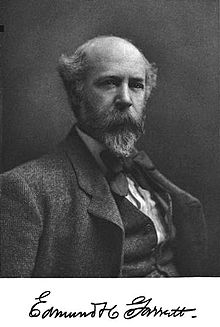Loading AI tools
American painter, illustrator and author (1853–1929) From Wikipedia, the free encyclopedia
Edmund Henry Garrett (1853–1929) was an American illustrator, bookplate-maker, and author—as well as a highly respected painter—renowned for his illustrations of the legends of King Arthur.
This article includes a list of general references, but it lacks sufficient corresponding inline citations. (May 2022) |
Edmund H. Garrett | |
|---|---|
 Portrait of Garrett, c. 1904 | |
| Born | October 19, 1853 Albany, New York, US |
| Died | April 2, 1929 (aged 75) |

Garrett was born in Albany, New York on October 19, 1853. While little is known of his initial art education, Garrett rose through the ranks to become a distinguished member of the Boston Art Club and the Copley Society of Art, and was an acquaintance and colleague of renowned impressionist artist Childe Hassam. He studied at the Académie Julian in Paris under Gustave Boulanger, Jules Lefebvre, John Paul Laurens, and Hector Leroux. After residing in Paris for approximately five years, he returned to America to establish a successful studio in Boston.
His first original wood engraving was created in 1879 under the tutelage of Robert Swain Gifford. His first original prints specialized in both architectural views and landscapes, with his later etchings mostly featuring areas around Boston.
Garrett provided the chief influence for Childe Hassam's first study trip to Europe in July 1883. On June 30, 1883, Garrett and Hassam sailed to Europe aboard the SS Anchoria, then travelled for several months throughout Great Britain, The Netherlands, France, Italy, Switzerland and Spain studying paintings from the old masters and creating watercolors of the European countryside. In late August 1883, both Garrett and Hassam sailed aboard the SS Alsatia to several Spanish ports before crossing the Atlantic back home.
After they both returned to Boston, Garrett resumed his illustration work for various publishers, which was very much in demand, keeping him from spending energy on his watercolors. During this time, Garrett worked at a studio located at 12 West Street in Boston, which he shared with Hassam and fellow-artist Charles Henry Turner.
In 1884, Garrett exhibited two watercolors at the Pennsylvania Academy ("A Street in Granada" and "El Mirador de la Reina, Alhambra") in 1884. He also exhibited "A Street in Granada" at the "Third Annual Exhibition of the Paint and Clay Club," which was held at the Gallery of the Boston Art Club in March 1884.
During the last two decades of the nineteenth century, Edmund Garrett's paintings and etchings were widely exhibited throughout the United States and in France at the Paris Salon.
During his lifetime, Garrett was a prolific illustrator of many books and publications, including various books of poetry by Tennyson, Keats, and Schiller; the Legends of King Arthur; Austen's Pride & Prejudice; Marie Louise de la Ramée's (Ouida's) A Dog of Flanders; stories by Alexandre Dumas; various books of Elizabethan and Victorian songs; and other books by Longfellow, Sir Walter Scott, Shelley, Wordsworth, and Hawthorne, among others.
Today, Garrett's works adorn the walls of the Art Institute of Chicago, Metropolitan Museum of Art in New York, and the New York Public Library, the Boston Public Library, and the Massachusetts State House. Other works appear in collections at the Public Library in Winchester, Mass; Calumet Club (Boston, Mass.), Brookside Library; Conant Memorial Church; and the Fine Arts Museum of San Francisco.
Garrett died in Needham, Massachusetts on April 2, 1929.




Seamless Wikipedia browsing. On steroids.
Every time you click a link to Wikipedia, Wiktionary or Wikiquote in your browser's search results, it will show the modern Wikiwand interface.
Wikiwand extension is a five stars, simple, with minimum permission required to keep your browsing private, safe and transparent.